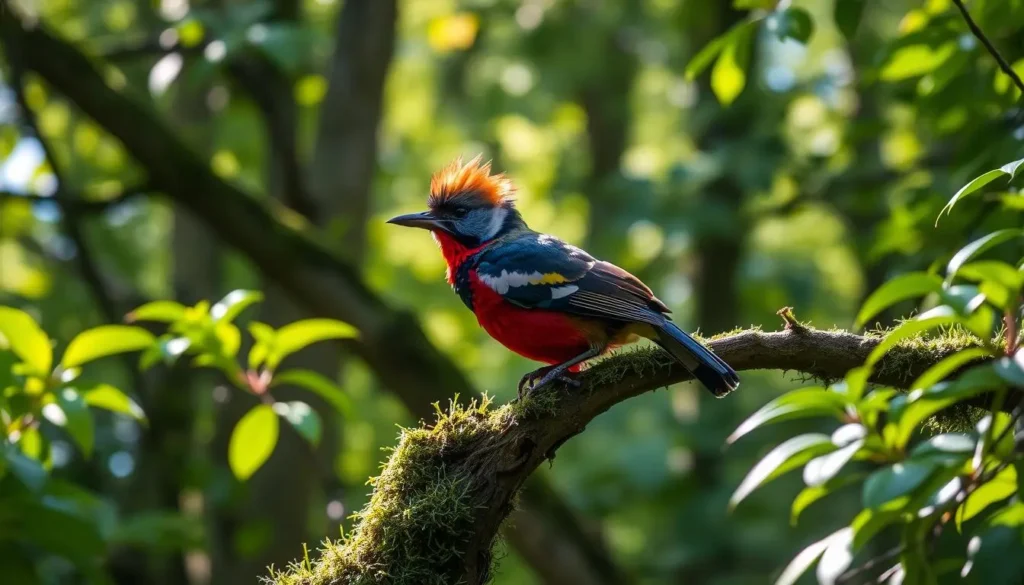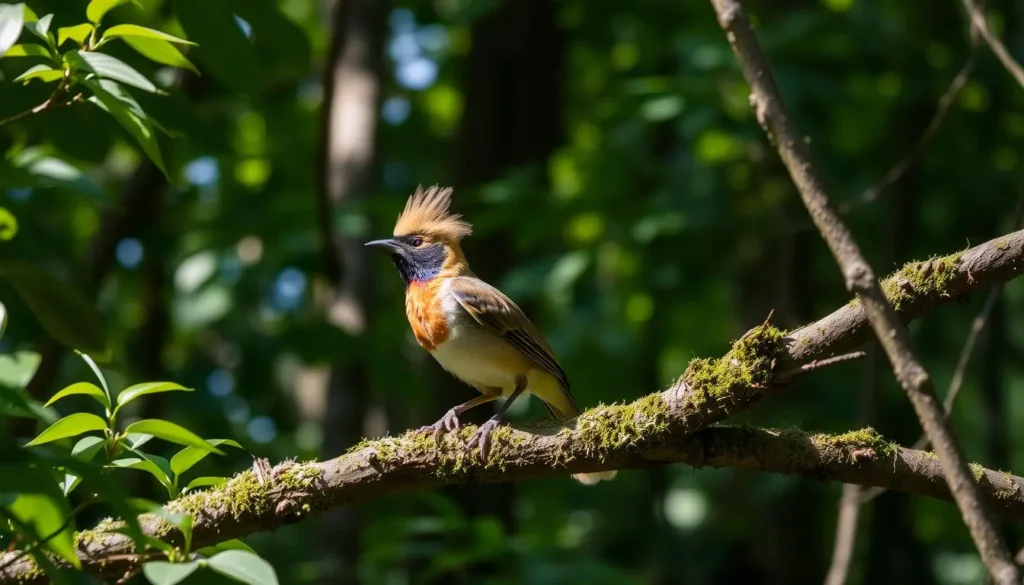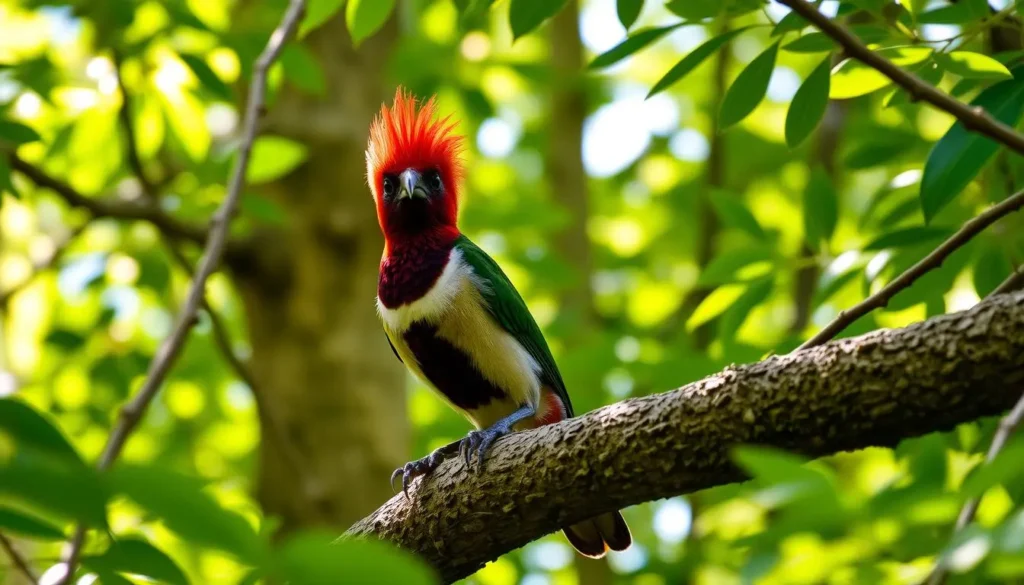Table of Contents
Get ready to explore the secret world of the crested woodland bird. These birds live in forests and woodlands all over the world. They have special looks, behaviors, and ways to adapt that make them very interesting to watch and learn about.
From their unique crest to their complex courtship dances, their lives are full of wonder and secrets. It’s exciting to discover what makes them so special.

Key Takeaways
- Crested woodland birds are a unique species found in forested habitats worldwide.
- They have distinctive physical features, including a prominent crest on their head.
- These birds exhibit fascinating behaviors, such as complex courtship displays and unique nesting habits.
- Crested woodland birds play a vital role in the ecosystem, contributing to the overall biodiversity of their habitats.
- Understanding the threats facing crested woodland birds, such as habitat loss and climate change, is crucial for their conservation.
What is a Crested Woodland Bird?
Crested woodland birds are amazing creatures that live in forests and woodlands. They are known for their unique crested heads. These birds can raise and lower their crests to show emotions and talk to their group.
Physical Characteristics and Habitat
The crested woodland bird’s look is truly amazing. They are small to medium-sized with bright colors like green, brown, blue, yellow, and red. Their crested heads make them stand out, giving them a regal look.
These birds are great at living in dense forests. They move easily through the trees, using their sharp senses to find food and stay safe. They also build their nests in these places.
Unique Behaviors and Adaptations
Crested woodland birds are full of interesting behaviors and adaptations. They are very social and active, always moving to find food like insects and berries. They are also very good at communicating with each other.
One of their coolest features is their crests. They can raise and lower their crests to show their mood and status in the group. This is how they talk to each other.
They also have special features like sharp beaks and strong feet. These help them move around in the forest and find different types of food.

Crested Woodland Bird: A Captivating Sight
The crested woodland bird is a true marvel of nature. It captures the hearts of birdwatchers and nature lovers. Their vibrant plumage and graceful movements make them a joy to watch in their natural habitats.
One of the most striking features of the crested tit is its distinctive crest. This feathered crown adds elegance and regal charm to their appearance. The crest’s color varies from bold reds and oranges to subtle gray and brown, depending on the species.
Beyond their eye-catching crest, these birds have a wide range of colors and patterns. Their feathers show a kaleidoscope of hues, from deep blues and greens to soft, muted tones. This vibrant plumage enhances their beauty and helps them communicate and identify within their species.
As these birds move from branch to branch, their grace is captivating. They hop and flutter with fluid elegance, showing their agility and adaptation to the dense woodlands they inhabit.

The crested woodland bird’s captivating appearance is also enhanced by its intriguing behaviors. From unique courtship displays to intricate nest-building, these birds offer a fascinating glimpse into their secret world. Birdwatchers and nature enthusiasts are eager to learn more about these remarkable creatures.
The Alluring Courtship Rituals
Watching the crested woodland birds courtship is a joy for bird lovers. These birds show off with complex displays and sounds to find mates. They aim to secure a spot in the breeding season.
Mating Season and Nesting Habits
When it gets warmer and days longer, crested woodland birds start their mating dance. Males flaunt their bright feathers and head crests. They dance and fly high to win over females. They also sing songs to show off and claim their place in the group.
After finding a mate, the pair picks the best nesting spot. It’s often in a tall tree or shrub. The female crested tit builds the nest with twigs, leaves, and more. She makes a safe and cozy home for her babies.
“The courtship rituals of the crested woodland bird are a true marvel to behold, showcasing the intricate beauty and complexity of avian behavior.”
Learning about the crested woodland bird‘s courtship and nesting shows us their amazing survival skills. It helps us appreciate these incredible birds more.
Crested Woodland Birds and Their Role in the Ecosystem
Crested woodland birds are key to keeping their forest homes healthy. They are not just passive residents; they actively help their ecosystems thrive.
When crested woodland birds search for food, they spread seeds and help plants grow back. They also keep insect numbers in check, keeping plants healthy. Their nests offer shelter and breeding spots for many other animals, creating a strong bond within the ecosystem.
Also, crested woodland birds act as important signs of their environment’s health. Their presence or absence can warn scientists and conservationists of any ecosystem problems.
| Ecosystem Role | Importance |
|---|---|
| Seed Dispersal | Facilitates plant regeneration and diversity |
| Insect Population Control | Maintains a balanced ecosystem, protecting plant life |
| Habitat Provision | Supports the nesting and breeding of other species |
| Environmental Indicator | Signals changes in the overall health of the ecosystem |
Understanding the crucial role of crested woodland birds helps us see why we must protect them. Their existence shows the fine balance of nature. Saving them is essential for the health of their woodland homes.
“Crested woodland birds are the unsung heroes of the forest, quietly shaping the very ecosystems that sustain them.”
Threats and Conservation Efforts
The crested woodland birds face many challenges in their natural habitats. One big threat is the loss and fragmentation of their homes due to human activities. These include deforestation, urbanization, and agricultural expansion.
These birds need dense, mature forests for nesting, feeding, and shelter. The destruction of their habitats can severely harm their populations.
Climate change also affects these birds. Changes in temperature, precipitation, and extreme weather events can disrupt their ecosystems. This can lead to fewer food sources and nesting sites, causing population declines and the risk of local extinctions.
Conservation Efforts
There are dedicated efforts to protect the crested woodland birds and their habitats. Organizations, government agencies, and local communities are working together. They are implementing various strategies, including:
- Designating protected areas and national parks to safeguard the remaining woodland habitats
- Implementing reforestation and habitat restoration programs to expand and reconnect fragmented forests
- Promoting sustainable forestry practices and limiting deforestation activities
- Educating the public and raising awareness about the importance of crested tit conservation
- Conducting scientific research to better understand the species’ ecology and develop more effective conservation measures
These efforts are crucial for the long-term survival of the crested woodland birds. They help maintain the ecological balance of their woodland ecosystems.
| Threat | Impact | Conservation Measures |
|---|---|---|
| Habitat Loss and Fragmentation | Decline in population, reduced breeding success, and loss of genetic diversity | Establishing protected areas, reforestation, and promoting sustainable forestry |
| Climate Change | Disruption of ecosystems, changes in food availability and nesting sites, increased vulnerability to extreme weather events | Monitoring and research, adaptation strategies, and climate-smart conservation practices |
Birdwatching and Spotting Crested Woodland Birds
Birdwatching is a fun hobby that lets people explore the world of crested woodland birds. These birds live in their natural homes, showing us how they behave and adapt.
To see crested woodland birds, you need to know where they like to be. They love dense woods, where they search for food or rest on branches. Watching them closely and patiently is important, as they can be hard to spot.
The best times to see crested woodland birds are early morning or late afternoon. This is when they are most active. Also, listen for their unique sounds, as you might hear them before you see them.
| Optimal Viewing Times | Favorable Habitats |
|---|---|
| Early morning (7-10 AM) | Dense, mature forests |
| Late afternoon (4-7 PM) | Wooded parks and nature preserves |
With patience and a sharp eye, birdwatchers can see the special ways crested woodland birds live. They can watch their courtship dances and how they find food. These birds give us a peek into the natural world.
“Birdwatching is not just about ticking off species; it’s about connecting with the natural world and experiencing the wonder of these incredible creatures.”
By using these tips, nature lovers can start an exciting adventure to find crested woodland birds.
Best Locations to Observe Crested Woodland Birds
For those who love birdwatching, there are great places to see the crested tit. These birds are known for their unique looks and behaviors. They can be found in many national parks and nature reserves across the country.
National Parks
Great Smoky Mountains National Park is a top spot to see these birds. It spans the border of Tennessee and North Carolina. The park’s varied habitats are home to many bird species, including the crested tit.
Visitors can join guided tours or hike the park’s trails. This way, they might see these birds in their natural setting.
Shenandoah National Park in Virginia is another great place. It’s in the Blue Ridge Mountains. The park has trails and observation decks where you can see these birds in the forest.
Nature Reserves
For a closer look, try visiting nature reserves. The Audubon Society’s Conanicut Island Sanctuary in Rhode Island is perfect. It’s a great place to see these birds as they forage and nest in the woodland.
In the Pacific Northwest, the Nisqually National Wildlife Refuge in Washington is famous for birdwatching. It has wetlands and forests, attracting many bird species, including the crested tit.
| Location | Key Highlights |
|---|---|
| Great Smoky Mountains National Park | Diverse habitats, guided birdwatching tours, well-marked trails |
| Shenandoah National Park | Hiking trails, observation decks, Blue Ridge Mountain scenery |
| Audubon Society’s Conanicut Island Sanctuary | Specialized birdwatching experiences, diverse woodland habitats |
| Nisqually National Wildlife Refuge | Mix of wetlands and forests, haven for avian species |
Fascinating Crested Woodland Bird Facts
The crested woodland bird is a stunning creature that lives in dense forests. It has striking features and a rich history that fascinates many. Birdwatchers and nature lovers find these birds truly captivating.
Longevity and Adaptations
Crested woodland birds can live up to 15 years in the wild. This shows how well they adapt and survive. Their unique crest and camouflage help them blend into their forest home.
Myths and Legends
These birds have been part of many myths and legends. In some cultures, they guide souls to the afterlife. Others believe they bring good luck, signaling prosperity.
“The crested woodland bird is a true guardian of the forest, its ethereal presence inspiring wonder and reverence in all who encounter it.”
From their long lives to the myths around them, the crested woodland bird is fascinating. Learning more about them helps us appreciate nature’s beauty and diversity.
The Future of Crested Woodland Birds
The future of crested woodland birds is a mix of worry and hope. These birds, known for their crests and bright colors, face many dangers. These dangers threaten their survival.
Habit loss and habitat fragmentation are big problems. As land use grows, these birds’ homes are destroyed. They must adapt or risk disappearing.
But, there’s hope. Conservation efforts are increasing. Scientists and groups are studying these birds and working to save their homes.
By watching, teaching, and involving communities, we can help these birds. We can make people care about and protect their habitats.
The crested woodland bird’s future is up to us. If we commit to saving them, they can continue to enchant us for years.
| Conservation Efforts | Projected Impact |
|---|---|
| Habitat Restoration | Increased population sizes and broader distribution of crested woodland birds |
| Breeding and Reintroduction Programs | Strengthened genetic diversity and resilience of crested woodland bird populations |
| Community-based Conservation Initiatives | Greater public awareness and active participation in protecting crested woodland bird habitats |
“The future of the crested woodland bird is inextricably linked to the health of our forests and the actions we take today to preserve them. With diligence and foresight, we can ensure these captivating birds continue to grace our world for generations to come.”
The future of crested woodland birds is complex. We must stay alert and use new ways to save them. By loving and protecting these birds, we can help them thrive.
Conclusion
We’ve learned a lot about the amazing crested woodland birds and their world. They stand out with their unique looks and behaviors. They also play a key role in their ecosystems.
These birds face dangers like losing their homes and climate change. But, thanks to conservation groups and birdwatchers, there’s hope. By protecting their homes, we can help them survive and amaze us for years.
This journey has taught us about crested woodland birds and why we must save their homes. Let’s support conservation, go birdwatching, or just enjoy nature. Together, we can protect these birds and their homes for the future.
FAQ
What is a crested woodland bird?
A crested woodland bird has a unique tuft of feathers on its head. They live in wooded areas like forests and woodlands.
What are the physical characteristics of a crested woodland bird?
These birds have bright colors like reds, blues, greens, and browns. They have a special crest on their head. They are small to medium in size and live in tree branches.
What are some of the unique behaviors and adaptations of crested woodland birds?
They are great at moving through dense foliage. They use their agility and sharp eyesight to find food. They also have special courtship and nesting behaviors.
What role do crested woodland birds play in their ecosystems?
They help keep their habitats healthy. They spread seeds, pollinate, and control insect populations. They also show how well their habitats are doing.
What are some of the threats facing crested woodland birds?
They face threats like habitat loss and climate change. Deforestation and urbanization harm their homes. We need to protect their habitats to save these birds.
Where can you best observe crested woodland birds?
You can see them in national parks and nature reserves. These places have the right kind of habitats. They are most active during the breeding season.
What are some fascinating facts about crested woodland birds?
These birds have long fascinated people. Some live for decades in the wild. Their crests have special meanings in many cultures.
Comments are closed.